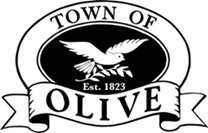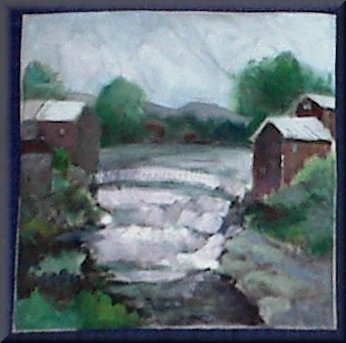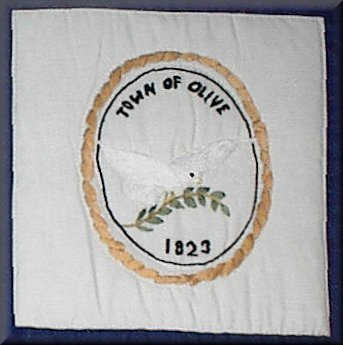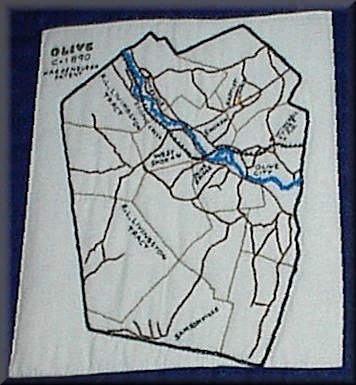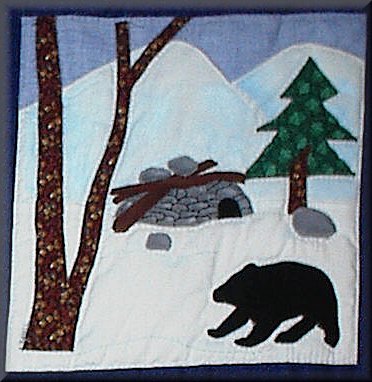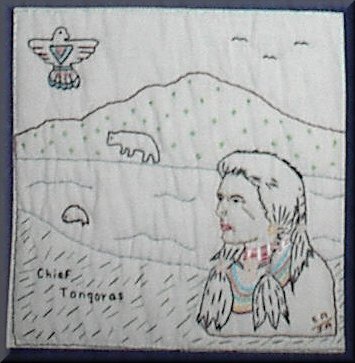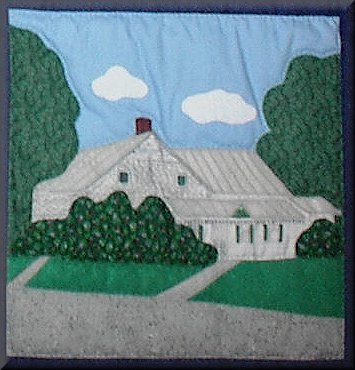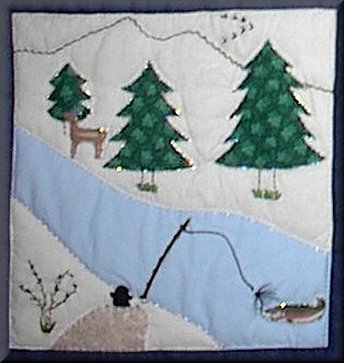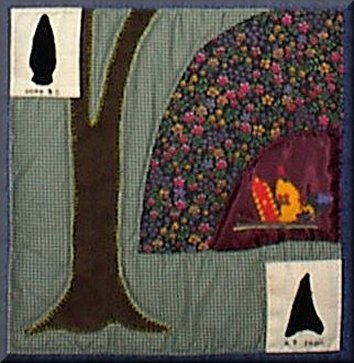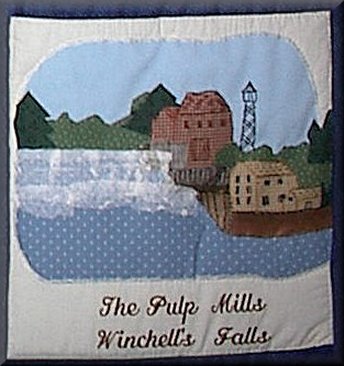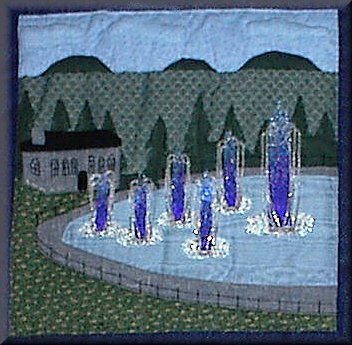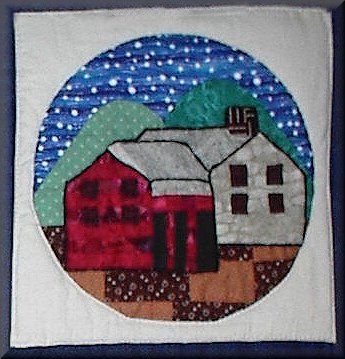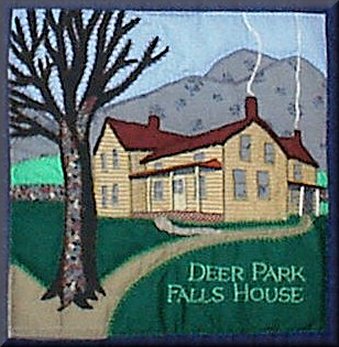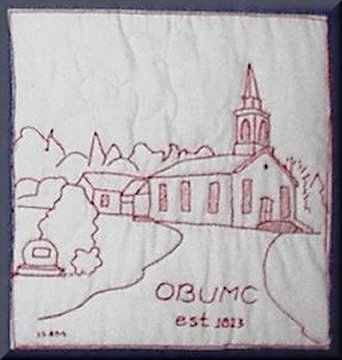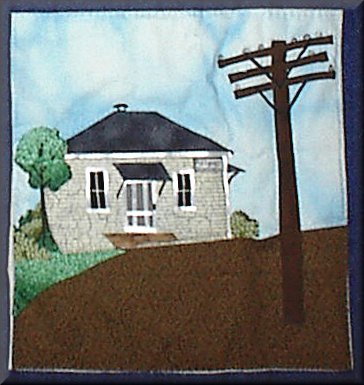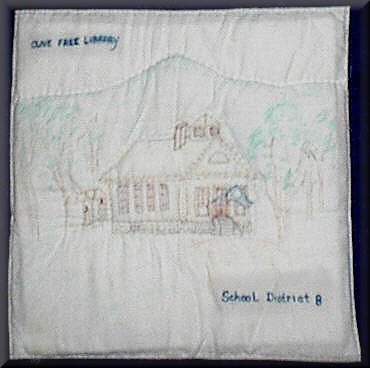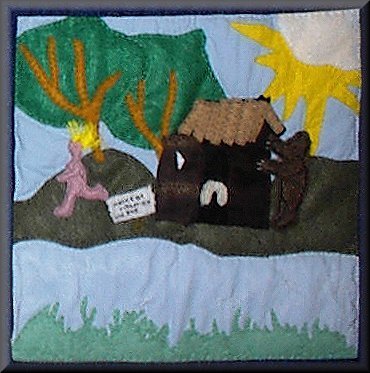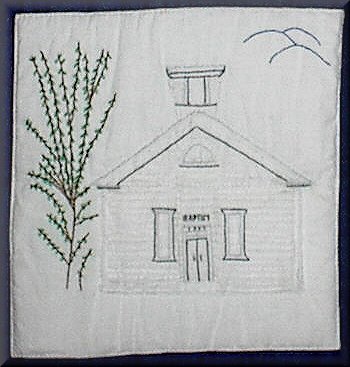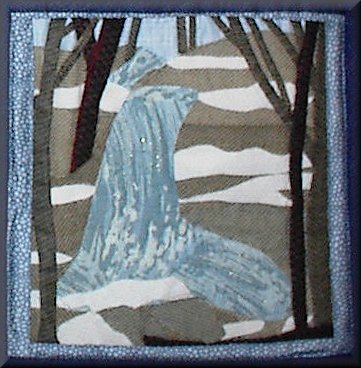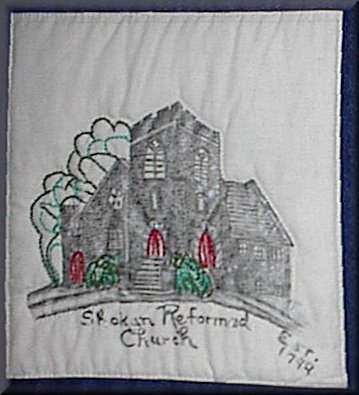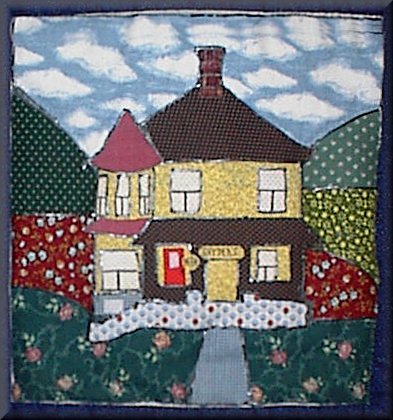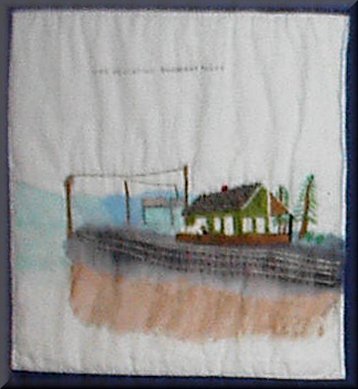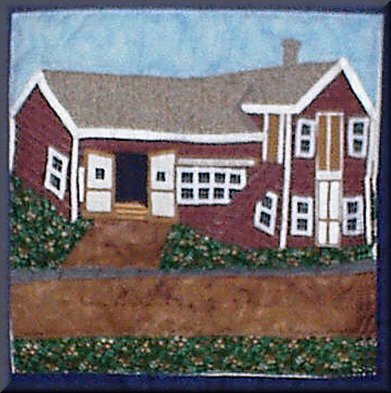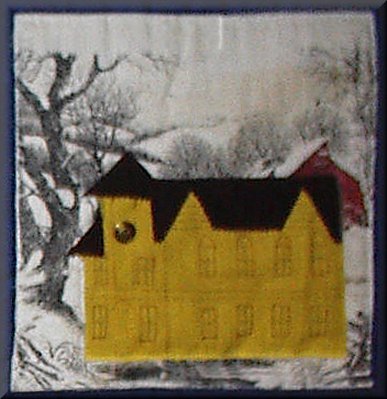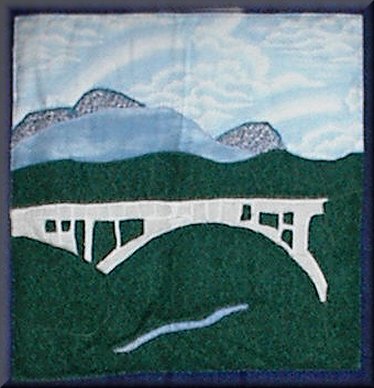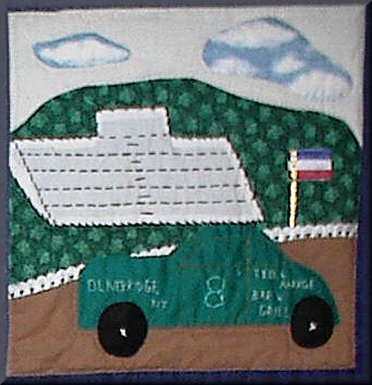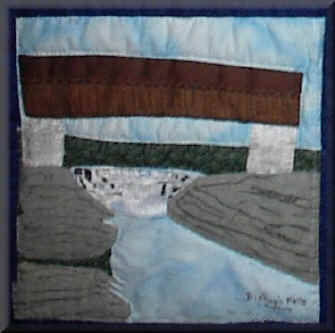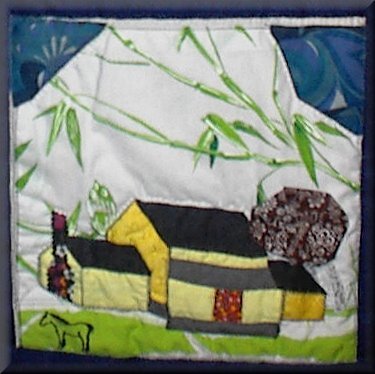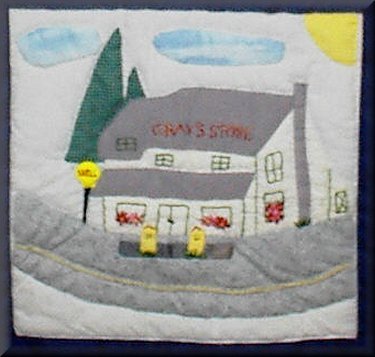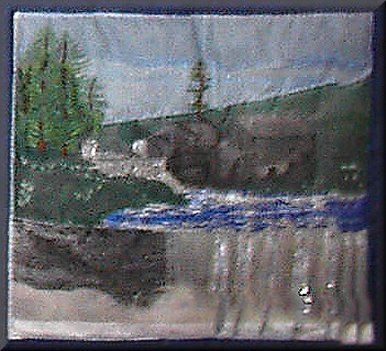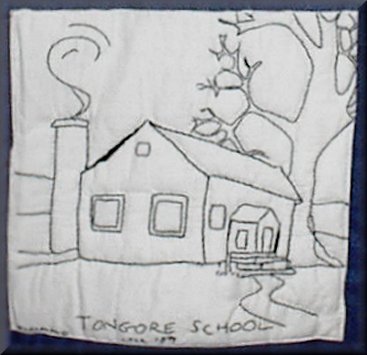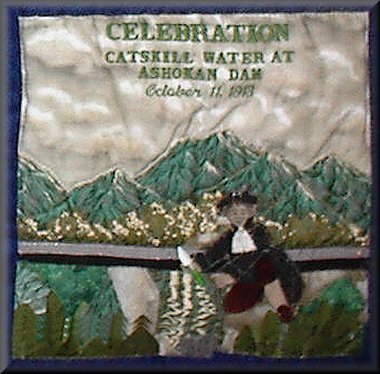History
1999 Historical Quilt

Master Quilters
Elizabeth “Bette” Cady
Ruth Ann Muller
Shirley Sampsen
Quilt Lettering
Susan Henderson Burgher
Elizabeth “Bette” Cady
Sylvia Rozzelle
Quilt Layout and Color Coordinating
Elizabeth “Bette” Cady
Susan Toleno Hyde
Ruth Anne Muller
Sylvia Rozzelle
Quilt Organizer
Sylvia Rozzelle
Quilt Program Development and Design
Leslie Lohrer
Quilt Assembler
Elizabeth “Bette” Cady
Emblems for Quilters
Susanne Toleno Hyde
Digital Images for Brochure: Susan Henderson Burgher, Rob Every, Susan Toleno Hyde
The colorful ribbon emblem pin was designed and crafted by Susanne Toleno Hyde. Persons involved in the handcrafting and assembly of the quilt wore them at the Town’s 175th anniversary celebration. The two white ribbon emblems signified the youngest quilter, Page Kathleen Chase, and our eldest quilter, Margaret Wendt.
Quilt Squares
Bishop's Falls
Kate McGloughlin
Shirley Sampsen
Bishop’s Falls was located a short distance from Olive City and Brown Station. Asa Bishop built a stone house and a grist mill above the falls. His son, Jacob, was blinded by small pox at the age of four. He learned milling and later ran the mill at night while his sons ran it in the day. Blind Miller Jake was regarded as a unique individual doing many things as well as those with the keenest of sight. The Bishop home was the first destroyed in the building of the Ashokan Reservoir as it was in close proximity to the actual dam. John I. Boice, the last occupant, received $112,000.00 from the City of New York for the loss of the farm and water power from the falls. This was the largest amount paid to a single landowner outside of the amount received by the Ulster and Delaware Railroad company.
Town of Olive Seal
Carmen Ajce
The Seal for the Town of Olive was adopted by the Town Board on November 9, 1971, in celebration of the Town’s Sesquicentennial. Vera Sickler was Town Historian at the time and recommended the Town Board approve the seal that was designed by Tisanne Gardner of Boiceville.
Town of Olive Map
Debbie Leacock
The Town of Olive was organized by New York State charter on April 15,1823. It was formed from portions of the Towns of Woodstock, Marbletown and Hurley. The first Town Board meeting was held a year later on the second Tuesday of May, 1824. In 1853, a rearrangement of town lines took place so that the Towns of Woodstock and Olive each received a portion of the territory of the other. This map, circa 1890, shows roads and district boundaries prior to the building of the Reservoir.
Bear Pen
Janette Kahil
A bear pen was normally laid in the ground with stone, though some were made from logs. It was a baited trap with a door for catching bears whose fat, fur, and meat were of major value to early settlers. One known bear pen in Olive, whose remains are still evident, is located across from the Olive Free Library on NY City property. It was built in approximately 1810 on the Peter Eckert property in West Shokan.
Chief Tongoras
Elisabeth Lang Alexander
Jennifer L. Alexander
The Esopus Indians, as the Dutch called them, traveled from the Delaware River Valley to the Hudson River Valley through the “Blue Hills” or Catskills. In and around the area of Olivebridge, once named Tongore, these tribes would travel through harvesting apples and game. Legend has it that when Chief Tongoras passed away, he was buried by the Esopus Creek with a pot of gold at his feet.
Gordon Craig Home in Olivebridge
Geraldine Maloney
The cornerstone for the beautiful stone home on Route 213 in Olivebridge reads “F. K. a.d. 1808”. Though we are unsure who F.K. refers to we know that the first Town of Olive Supervisor in 1824, Gordon Craig, lived in this house. It still stands as stately as it did over 190 years ago. It has been called home by over four generations of the Lester A. Davis family.
Jacky Brook
Sylvia Rozzelle
Francina Gunthorpe
Written by Jack Bierhorst
The Jacky Brook is named for an African American freedman, Jack Crispell, who made his home along its banks. Crispell, a horse trainer, was one of the early residents of West Shokan. No longer standing, his house dates from the period 1800-1850. The Jacky Brook rises on the northeastern slopes of High Point Mountain, the highest peak in the Town of Olive. Flowing toward the Esopus Creek, impounded since 1916 to form the Ashokan Reservoir, it joins the Beekman Brook just east of Route 28A in West Shokan.
Native American Rockshelter
Jane Byers Bierhorst
written by Jack Bierhorst
The cottage rockshelter in Samsonville is one of several Native American sites in Olive. A natural chamber beneath an overhanging cliff, it was used by hunters as early as 2000 BC and possibly as late as AD1600. Stone blades, a pottery fragment, and several projectile points from the site can be seen in the Bishop Museum at the Olive Free Library. These include the Normanskill point and the Levanna point shown in the quilt square. The site is registered with the New York State Museum as Site 8111.
The Pulp Mill at Winchell's Falls
Barbara Planz
Gail Hardy, lettering
Winchell’s Falls is located on what is known today as the SUNY New Paltz Ashokan Field Campus. Prior to the construction of the reservoir the falls was a bustling manufacturing center since the Esopus Creek flowed with such force down through Cathedral Gorge and over the falls. In 1875, DuPont de Nemours of Delaware took over the falls and built a pulp mill to make ingredients for dynamite. In 1909, the Eastern Dynamite Company went to court against the New York City Board of Water Supply for the loss of the volume of water at the falls. This was the first of the riparian rights cases to reach the courts.
Ashokan Reservoir Aerators
Susanne Toleno Hyde
The first aeration of Ashokan Reservoir water began on July 23, 1915. Since stumps were not removed from the reservoir basin, the aerators were originally built to eliminate algae. It became apparent that algae was not a problem but the aerators continued in operation simply for the purpose of adding oxygen to the water. There was no pump involved in the aeration process. The water sprayed up due to the elevation of the water. In the early 1980’s the aerators were replaced by the current Ashokan Fountain.
Merrit Winchell House in Olivebridge
Nancy Silvestri
In 1800 Peter Merrihew built the lovely home still standing on Route 213 which in later years became known as the Winchell house. It operated for years as the Tongore Inn and tavern providing rest for both stagecoach passengers, teamsters, and horses. In later years, owned by the Winchell family, it operated as a dairy farm, and even later as a restaurant. Raymond Davis operated the Onteora Speedway Park on this farm in the late 1960’s.
Deer Park Falls House
Angela Erenberg
Deer Park was the name given to the original land grants in the Krumville area. The Deer Park Falls house sits above the falls on the county road and currently operates as the Country Inn in Krumville. It has always been a center of business activity in Krumville operating as a boarding house and inn. The Post Office was located in a building near here.
Olivebridge United Methodist Church
Shirley Sampsen
Sarah Stitham
The first Methodist Church in the Town of Olive was organized at Tongore (Olivebridge) and a church was built in 1823 on the site now occupied by the present church edifice. The circuit at the time included most of the territory lying in Ulster County and into Delaware County. The Olivebridge (Tongore) United Methodist Church was a member of the Sunday School Association of the Town of Olive which was organized in 1888. In 1998 this church celebrated its 175th anniversary.
Brown Station Post Office
Mae Brenner
Henry Brenner
In 1880, Brook’s Crossing was renamed Brown Station. Both names can be associated with early families settling in this area before 1800. The little hamlet sprawled from the present Ashokan Fountain to the upper basin of the reservoir. Brown Station was the first railroad station entering the Town of Olive after leaving Olive Branch Station in Hurley. In 1893 the Brown Station Post Office was established-soon to be discontinued in 1918 after the completion of the Reservoir.
Olive Free Library and West Shokan School District #8
Ruth Anne Muller
The plan for establishing a library in the Town of Olive grew out of an idea in the minds of Claire and Joseph Friedberg. After months of working through informal discussion, in 1952 a large group of residents met at the Friedberg’s home for an organizational meeting. They contacted the State Education Department to become accredited, formed a Library Association, and elected officers and trustees. District No. 8 West Shokan Schoolhouse was turned over to the Library Association and in 1959 the Olive Free Library became a member of the Mid-Hudson Libraries System.
Catskill Mountain Outhouse
Susan Henderson Burgher
Mary Giuliano
From 1882 to 1908 the Town of Olive’s Board of Health not only addressed problems of quarantines and infectious diseases, but tended to concerns of privies operating over mountain streams. After the building of the Ashokan Reservoir the New York City Board of Water Supply worked to correct unsanitary privy conditions where streams were directly polluted. They also offered models for proper outhouse construction. In 1997, land use regulations were implemented through the Memorandum of Agreement with the City of New York. Though Bureau of Water Supply designed outhouses have changed to architecturally designed septic systems, the concern for guaranteeing the purity of the Ashokan Reservoir has not changed.
Old School Baptist Meeting House
Kirsten Nissen
The Olive and Hurley Old School Baptist Meeting House was organized September 2, 1799 in Olive City. It is the third oldest of the Primitive Baptist sect in New York State. In 1857 the present church was built to accommodate its growing congregation. This one-of-a-kind church received National and State Historic Landmark designation in 1998 and is celebrating its 200th birthday this year.
Maltby Hollow Falls - Winter Scene
Sandy Friedel
Maltby Hollow Falls is located up the Moonhaw valley in West Shokan. It is named for the Maltby family who took over the sawmill site at the falls in the 1880’s and extensively developed the charcoal burning business. On the site that once was busy with over one hundred working men, now remain only a few remnants of the toppled kilns.
Shokan Reformed Church
Margaret Wendt
Beverly Stein
written by Beverly Stein
On the first Tuesday of May, 1799, “Rev. Stephen Goetschius (Minister at Marbletown) and G. Mandeville were appointed to a Committee to Ordain Deacons and Elders and to organize a Church.” On July 7, 1799, the Consistory had been chosen and on February 22, 1800, the Consistory first met at the home of Elder Andrew Hill. Uriah Hill was the First Clerk and Fredrick Bush was the First Treasurer. In 1823, the Town of Olive was formed and the Brown Station Church was no longer in the Town of Marbletown. Due to the construction of the Ashokan Reservoir the Church purchased land at its present site. The present Church was dedicated on September 14, 1913. In 1999, the Shokan Reformed Church is celebrating its 200th Anniversary.
Snyder's Tavern
Dolores Scofield
Snyder’s Tavern was built in 1910 in West Shokan, originally operating as a boarding house. In 1933, after prohibition ended, Mabel S. Snyder received one of the first liquor licenses in New York State. The Tavern has operated for three generations of the Snyder family, currently being operated by Mabel Snyder’s grandson, Chester Scofield. It remains one of the oldest liquor licenses in New York State. In 1947, Snyder’s Tavern became home to the Bushkill Rod & Gun Club. Taverns and Inns in Olive were always a center of community events. Most probably Olive’s first Town Board Meeting was held In Uriah Schutt’s Tavern in 1824.
Brodhead Bridge Train Station
Lois Langthorn
Drawn by
Ruth Anne Muller
Brodhead Bridge train station was the first stop on the railroad west of Brown Station. It was a center of summer activity with several boarding houses providing rooms for the visitors the train would bring. The depot, surrounding homes and businesses were destroyed to make way for the Ashokan Reservoir.
George Siemon's Wagon and Blacksmith Shop
Anne Leifeld
The wagon and blacksmith shop was located on Main Street, West Shokan. It was a center of activity as people needed horses shod, wagons repaired, and metal formed Mr. Siemon organized a uniformed baseball team in 1884 which succeeded the Mountain Stars of earlier years. His wagon shop was built upon the Batement Stream on the former site of the Crispell family sawmill.
Pythian Hall
Mary Louise Schryver
Pythian Hall was located in old West Shokan and was the center of activity. At one time it was owned by a stock company and was the center of public gatherings, operas, plays, and social events. It was located next to the Roman Catholic Church in close proximity to the train station, which brought summer visitors from New York City to the mountains. The Hall was one of many buildings destroyed due to the construction of the Ashokan Reservoir.
Travel Hollow Bridge
Elizabeth “Bette” Cady
Under the Water Act of 1905 the City of New York constructed the Traver Hollow Bridge on Route 28A which spanned 473 feet across the steep ravine. It was built in 1913 and was regarded an engineering marvel at the time. The Water Act required the City of New York to build highways and bridges when they constructed a reservoir and required them to forever maintain them. The bridge was rendered unsafe and was closed completely in 1975. A new bridge was built and opened November 10, 1980.
Onteora Speedway Park
Sylvia Rozzelle
Onteora Speedway Park operated from 1960 through the early 1970’s. On Sunday afternoons at 2:30 pm racing fans would gather to watch some of the top racers perform. Since auto racing is a sport enjoyed primarily in rural communities, as the town grew so did objections to its operation. The Speedway was then closed. Remains of the Speedway Park can be seen near the Olivebridge Town Park.
Covered Bridge at Bishop's Falls
Mary Hesley
The covered bridge on the Esopus Creek at Bishop’s Falls was the subject of many travel postcards. It was destroyed by a flood and ordered rebuilt at a Town Meeting on May 30, 1854. In 1913 the rebuilt bridge broke loose in another flood and landed against the Ashokan Dam.
Peter Winchel Home on Ticenteneyck Mountain
Designed by
Page Kathleen Chase
and Helen Chase
Written by Helen Chase
The Peter Winchel home, against the backdrop of Ticeteneyck Mountain and Winchell Hollow, is situated at the end of Chase Road in the hamlet of Ashokan. Peter Winchel bought the property from Petrus DuBois in 1816, built the house in 1832, and sold it in 1834 to Jacob Winchel-who later sold it to Jacob Winchel, Jr. It remained in the Winchel or Van Winchell family until 1918. In 1920 Champion Clement Chase, and his wife Lula Belle Edwards Chase, purchased the old Winchell Farm and two years later purchased the adjoining Cudney abandoned farm.
The house has been owned since 1992 by Sherret Edwards Chase and Susan Ruth Page Chase. The center of the house was built prior to 1832, the section on the right is the kitchen, and the addition on the left was added in 1928 by Clement Edwards Chase (son of Champion and Lula Belle) to serve as a family living room. The house was renovated in 1996-1999 by Sherret Edwards Chase.
The horse in the scene was drawn by Page Kathleen Chase and represents two beloved horses. “Fire” was owned by Sherret S. Chase in the 1930’s and “Phineas” cared for by Page Kathleen Chase in the late 1990’s.
George Van Kleeck Blacksmith Shop
Elizabeth “Bette” Cady
Quoted from
Dorothy Barringer
Van Kleeck Smith
“My great grandfather Jeremiah Van Kleeck was a blacksmith. He was born July 1805 and died 1885. He is buried in Palentown Cemetery. He built and lived in what I called the family homestead up on what is known as Upper Samsonville Road. I think some folks call it the Mountain Road or something–probably city folks. The original house was all log and set up above the house you see now, where George and Clara lived. Jeremiah’s blacksmith shop was right by the roadway. His son David, my grandfather, was a blacksmith and also operated the shop there as did my Uncle George Van Kleeck. My father, Abram Van Kleeck, also operated there for a while but he mostly moved around and finally had his last shop in Kingston. In the 70’s a group wanted to move the shop and all that was in it and rebuild it as one of these living museums. I always thought that was a shame that didn’t happen.”
Ethel Gray's Store
Lois Gray Kortright
Cecil and Ethel Gray opened a general merchandise store in Olivebridge in 1929. This country store offered feed packed in cloth for making dresses, coal from Pennsylvania, and ice cut from the weir which was stored in sawdust in an icehouse behind the store. Ethel’s brother, Lester S. Davis, ran the general store in West Shokan and also was Town of Olive Supervisor. Her other brother, Raymond, ran the Onteora Speedway Park and at one time owned the Tongore Inn. Cecil died in 1959 and Ethel continued running the store up until five weeks before she died in 1993. For over 60 years the store provided the community with a nucleus for social contact as well as materials and services.
Samsonville Heading/Shingle Mill and Saw Mill
Raecine Shurter
Marcus Heidelberg
John Shurter was one of the original Town Officers in 1824 and, along with his son Anthony, ran the mills at the top of the falls in Samsonville. The grist mill remained operative for six generations of the Shurter family until a flood in 1928 knocked it from its foundation In addition to John and Anthony, the mill was run by Heman, Virgil, Jesse, and Lawrence.
Togrore School
Mildred “Mimi” McGloughlin
The first school in the Town was at Tongore. There was one also on the flat near the old Olive Bridge. The dates of these buildings are unknown. Land for the Tongore School was donated by Andrew C. Davis and the building still stands today on Mill Road showing little change from its original design. As a young man, John Burroughs taught school at Tongore in 1854-1855 where he earned enough money to attend the Cooperstown Seminary during the spring term of 1856.
Ground Opening of the Ashokan Dam
Barbara Allison
Gail Hardy, lettering
On October 11, 1913, the City of New York Board of Water Supply had a grand opening in “Celebration of the Beginning of Storage of Catskill Water at Ashokan Dam.” Construction started on the reservoir September 30, 1907, and impounding of water began September 9, 1913. This quilt square is a replication of the opening day program lithograph. The menu for the dinner was Ashokan Cocktail, Pickles, Fried Chicken, Baked Sweet and White Potatoes, Green Apple Pie, Ice Cream and Cake, Crackers and Cheese, Beer and Soft Drinks.
